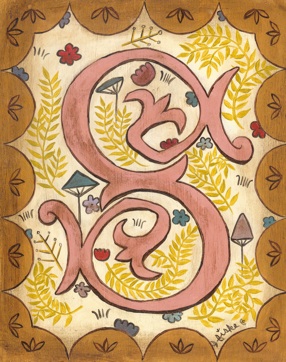Glossary
of Pysanka-Related Terms
Glossary
of Pysanka-Related Terms

S
sakvy (сакви): the word means saddlebags, and refers to a pysanka division that resembles them.
scevomorphic: having the form of farm objects, man-made ones. Scevomorphic symbols are those shaped like agricultural implements (rakes, combs, ladders, windmills, sieves, baskets, saws, etc.).
selo (село): a Ukrainian village. Pronounced “sell-O” (short vowels, the “o” as in long).
serpiginous: snake-like, it describes a winding, undulating type of meander line.
setting powder: citric acid, it can be added to aniline dyes in lieu of vinegar.
shellac: a varnish made from the crushed bodies of lac insects. It is water based, and should not be used on pysanky.
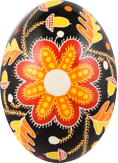
skryobanka (скрьобанка): scratch carve egg, also known as a dryapanka. The plural is skryobanky.
Sokal region (Сокальщина): an ethnographically distinct region within Lviv oblast, and bordering Volyn. Folk arts from this are have characteristics of both Halychyna and Volyn.
It is well known for its distinct black embroidery, and unique floral pysanky, many of which have asymmetric designs. This style arose in the early 20th century, and was the result of the popularity of floral painting among young women.
Sorbs: also known as Wends, Lusatian Sorbs or Lusatian Serbs. Sorbs are a Western Slavic people of Central Europe living predominantly in Lusatia, a region on the territory of Germany and Poland. In Germany they live in the states of Brandenburg and Saxony. They traditionally speak the Sorbian languages (Wendish, Lusatian) which are closely related to Polish and Czech.
Sorbian Easter eggs: called jejka pisać, they are of two types, wax resist and scratch-carve. The Sorbs are unique in using shaped feathers to apply wax, as in the example below.
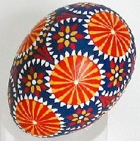
sorokoklyn (сорококлин): a traditional pysanka division, in which 48 triangles are created. The name comes from the Ukrainian words for “forty wedges.”
sosonka (сосонка): an ancient motif which appears similar to a pine branch, but without branching. The sosonka is the horsetail plant, the first greenery to appear in the spring. It is a symbol of spring, life, and rebirth.



spiral: ancient pysanka motif, it is a symbol of the serpent (zmiya), and a water symbol. Spirals can be simple or compound.
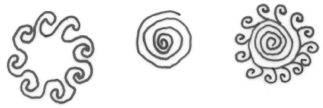
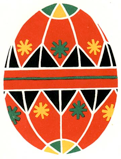
storchova ruzha (сторчова ружа): a ruzha motif centered on the end of a pysanka. It is one of the common types ruzha; the pysanka has an equatorial division. The example on the right is from the Chernihiv region of northern Ukraine.
stylus: the instrument used to write linear batik style pysanky, consisting of a handle (wooden or plastic) and a small metal reservoir (cone) with a writing tip. Also referred to as a tjanting, kistka, kystka, pysachok, pysal’tse.
Surma: a New York city store owned by the Surmach family which has been selling pysanky and other Ukrainian goods since 1918. They have their own line of dyes and sell postcards, booklets and boxed sets of pysanka supplies.
svarha (сварга): a swastika, it symbolizes the movement of the sun across the sky. It was also symbolic of the god Svaroh.

Svaroh (Сварог): the main god of the Slavic pantheon, the god of the sky, the sun, and heavenly fire (thunder). He was the father of Dazhboh and Svarozhych.
symbol: an object that represents, stands for, or suggests an idea, visual image, belief, action, or material entity. In pysankarstvo, symbols take the form of visual images/motifs and are used to convey ideas and beliefs. Some motifs are symbols; all symbols are motifs.
Back to Glossary home page
Back to MAIN Pysanka home page.
Back to Pysanka Index.
Search my site with Google
